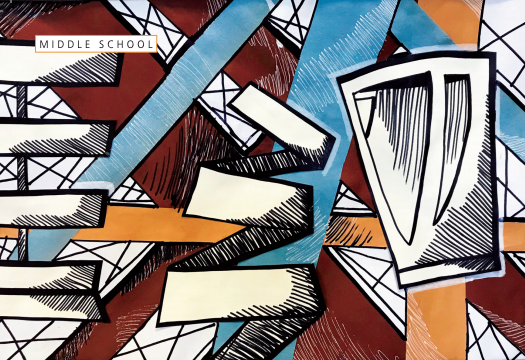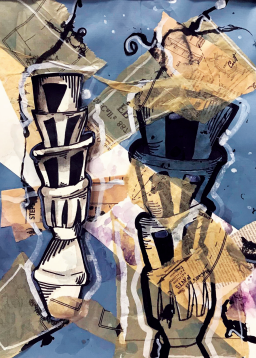 |
 |
| Dalia, a graphic approach. |
Ashlynn, an expressive approach. |
One of the reasons we love to teach at our school is because the high concentration of talent propels students to learn and grow at an accelerated rate. More importantly, students develop relationships and collaborate with one another freely—an ideal environment for many professional artists in the studio setting.
We emphasize this collaboration along with the eight Studio Habits of Mind right from the start. We encourage open dialogue and positive feedback for students to engage, persist, and reflect on their own process. This three-part project is a journey into months of intensive risk-taking, team building, and scaffolding with exceptional seventh-grade art students.
Part One: Sculptures
First, students created freestanding sculptures out of polystyrene cups. Polystyrene is great because it creates natural shadows and the form is easy to draw, it’s inexpensive and lightweight, and it’s a great way to upcycle discarded cups. Students worked in groups of three to four. Each student had a role within the group for each stage of the construction.
Each group was given the following criteria: the sculpture has to be freestanding and between one to two feet tall; each student has to design at least one of the cups in the sculpture; and students have to use all of the pieces. Creative freedom was encouraged with alternate materials such as other pieces of recycled polystyrene, wire, hot glue, thumbtacks, and even mini LED lights. As long as teams had a vision, they knew their “What ifs” would be met with our “Let’s try it and see!” Working collaboratively helped students create more freely, knowing if their sculpture idea “failed,” they’d have a team with whom they could regroup and brainstorm alternate approaches.
Part Two: Drawing
After building, students observed their sculptures as abstract compositional subjects for drawing. The main goals of the drawing portion were to teach students about observational drawing and encourage flexibility and confidence in arranging and composing artwork. To that end, we used a variety of strategies and techniques to help students grow their artistic voices and draw in a more expressive style.
Students experimented with pen, ebony pencil, black and white colored pencils, ink, and markers. They sampled six different drawing styles with the materials and even combined styles to create line personality.
 Alexis, a close-up study
Alexis, a close-up study
Pre-Assessment
Before the drawing portion, we conducted a pre-test to analyze students’ observational drawing skills and to help us individualize the lesson based on skill level. Students who scored strongly with proportion and accurate observational drawing skills were encouraged to take more risks with arrangement, line style, and creative expression. Students who scored in the middle or lower range were encouraged to focus more on the skills they needed to improve upon, such as developing strong contrast, focal point, or composition arrangement.
Part Three: Collage
The project spanned two weeks with intermittent progress checks and in-progress critiques. Students were reminded of the rule of thirds to create a focal point as well as the importance of balancing the positive and negative spaces.
During the collage portion, students made compositional choices and arranged their media before gluing anything to their paper. The collage and drawing materials in this lesson were simple enough to manipulate yet address a wide range of creative approaches. The use of two to three dry media was emphasized, yet students had creative freedom to experiment with acrylic and watercolor paints as part of the composition.
Reflect
After the project, students evaluated their experience in a blog-style post on their online digital portfolios. Self-evaluation is a great way to document their overall artistic growth and mindfulness about their own process. This three-part experience was a combination of creative thinking, collaboration, and compositional strategy. It helped students realize that when you build with confidence and flexible thinking, anything is possible!
Laura Lester and Christina Van Hamersveld teach art at Richardson West Arts and Technology Magnet School in Richardson, Texas. laura.lester@risd.org; christina.vanhamersveld@risd.org
NATIONAL STANDARD
Creating: Generate and conceptualize new artistic ideas and work.
WEB LINK
rwjhartmagnet.weebly.com
View this article in the digital edition.




 Alexis, a close-up study
Alexis, a close-up study